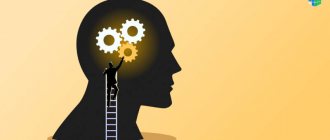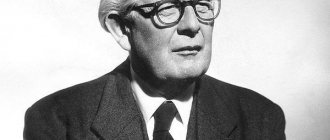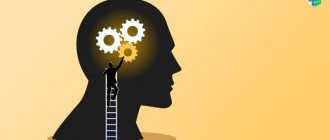Abstract to the Russian edition
The work of the Swiss psychologist Jean Piaget presents the essence of the theoretical concept of the development of intelligence, which is the basis, the core of mental development, the construction of which he carried out in the 1930-1940s. The author considered the principles of this concept to be key for understanding the evolution of thinking in different historical eras and for various fields of knowledge; He developed, based on this position, a special direction of research, which he later called genetic epistemology. The theory, the first ideas and provisions of which were formulated by the author in the first half of the 20th century, remains relevant and is still assessed by experts as one of the most productive in experimental and practical research.
Essence of the method
At a young age, Jean Piaget was interested in biology and constantly observed animals. The future scientist in the field of psychology presented the findings in detail in articles. The basis of his scientific life was the identification of the characteristics of children's and adolescent thinking.
The young researcher became a teacher at a boys' school in Paris. The director of the school was Binet, the inventor of IQ testing. Piaget collaborated with the leader, constantly helping him in processing the results.
According to the observations of a psychoanalyst, children of the same age category made approximately the same mistakes that adults never made. This became the basis of the future theory, which consists in the fact that human thinking undergoes a certain transformation at each age stage.
Piaget observed not only schoolchildren, but also his own children. The basis of the scientist’s scientific work was experiments. The psychologist also used the conversation method, which gave him a broad understanding of children's logic.
According to Piaget's theory, the main core of development of the mental sphere is intelligence.
Gradually, the child develops a more adequate scheme for understanding a certain situation, and the adaptation that occurs when interacting with the environment is traced. Each stage has typical logical errors.
Author's Preface to the First Edition
A book called “The Psychology of Intelligence” could cover a good half of the entire subject of psychology. But on the pages of this book the author will limit himself to outlining one general concept, namely the concept of the formation of “operations”, and will show, perhaps more objectively, its place among other concepts accepted in psychology. First, we will talk about characterizing the role of the intellect in its relation to adaptive processes as a whole (Chapter I), then, considering the “psychology of thinking,” we will show that the activity of the intellect consists essentially in “grouping” operations in accordance with defined structures (Chapter II). The psychology of intelligence, understood as a special form of balance to which all cognitive processes gravitate, poses such problems as the relationship between intelligence and perception (Chapter III), intelligence and skill (Chapter IV), as well as issues of the development of intelligence (Chapter V) and its socialization (Chapter VI).
Despite the abundance of valuable works in this area, the psychological theory of intellectual mechanisms is just emerging, and so far one can only vaguely guess what degree of accuracy it will have. Hence the feeling of searching that I tried to express here.
This little book sets out the essence of a course of lectures which I had the privilege of delivering at the Collège de France in 1942, at a time when all the university teachers were striving, in the face of violence, to express their solidarity and their fidelity to enduring values. In preparing this book, I cannot forget the reception given to me by my audience of those years, as well as the contacts that I had with my teacher P. Janet and with my friends A. Pieron, A. Vallon, P. Ginome, G. Bachelenrom, P. Masson-Ourselem. M. Mauss and many others, not to mention my dear I. Meyerson, who “resisted” in a completely different place 1.
Jean Piaget.
Criticism of the main provisions of the theory
Many scientists were critical of Piaget's idea of the nature of intellectual capabilities and the factors of their development. In his scientific work, the researcher did not deny the social role, but considered the biological factor to be decisive.
According to the psychologist, favorable conditions can only accelerate the change of stages, but no more. L. Vygotsky, M. Cole, Alexei Leontiev and many others disagreed with the scientist on this issue. Often disagreements in scientific circles were caused by the distinction between age periods and stages of thinking.
The psychologist believed that the age limits were determined with precision, but their variability depended on the specific sample of the child. According to Piaget, the formal layer of logic becomes accessible to teenagers.
But many experiments by other researchers have shown that boys and girls often fail to cope with the tasks assigned to them.
Research by L.S. Vygotsky, A.N. Leontyev, M. Cole, J. Werch do not contradict the scientific views of Piaget in that the formal logical stage of development is considered the highest level, but psychologists, in particular Daniil Elkonin, doubted that after 15 years the intellect ceases to undergo changes.
After all, a complex skill or activity requires constant improvement, and the thinking of a young person is fundamentally different from the logic of an experienced leader.
Author's Preface to the Second Edition
The reception given to this little work was generally quite favorable, which prompted us to republish it without changes. At the same time, many critical comments have been made about our concept of intelligence due to the fact that it is associated with higher nervous activity and the process of its formation in ontogenesis. It seems to us that this reproach is based on a simple misunderstanding. Both the concept of “assimilation” and the transition from rhythmic actions to regulations, and from them to reversible variations, require neurophysiological, and at the same time psychological (and logical) interpretations. Far from being contradictory, these two interpretations can ultimately be reconciled. We will dwell on this essential point elsewhere, but in no case do we consider ourselves entitled to begin to resolve this issue until the detailed psychogenetic studies of which this little book is a summary have been completed.
Jean Piaget. October 1948.
Stages of development of children's intelligence
The stages of intelligence development (according to Piaget there are 4 levels) are described in the scientist’s cognitive theory. Initially, the formation of sensorimotor structures occurs, suggesting reversibility of the action.
Then pre-operational ideas arise, which are the basis for the development of specific mental operations that involve systematic actions. They are often carried out based on visual data. And the final stage is the formal layer of intelligence.
This period is based on hypothetico-deductive reasoning. According to Piaget's teaching, development is a transition from a lower to a higher level. The previous stage serves as the basis for the next level. In development, it is not the replacement of one layer by another, but their integration.
Each stage is transformed into a more advanced level, which is characterized by a unique structure. But all stages have common functional indicators. To characterize the levels, scientists used a logical model.
Piaget noted that the analysis of structures does not use any quantitative measurements. The basis is the qualitative characteristics of mental abilities. The logical model was a tool for analyzing psychological reality.
Sensorimotor period (0-2 years)
Through the senses and motor abilities, the child learns about the world around him and begins to establish the simplest connections between his actions and consequences.
He realizes that he is a separate entity. But the internal plan is not accessible to children's thinking. He can only manipulate specific objects.
Determination test
First of all, the child understands that objects remain intact and change in time and space. If you hide a toy under a blanket that a 6-month-old baby is reaching for, he will stop and lose interest in the object, as if the toy had ceased to exist.
Based on experience, Piaget concluded that the child does not have an innate understanding of object permanence and acquires it during the first year of life. Awareness of permanence, according to the scientist, is a slow process.
And the baby’s action is a major achievement of intelligence at the level of sensorimotor perception of the world.
Period of preoperative ideas (2-7 years)
Piaget's stages of intelligence development include the pre-operational level. The formation of a child’s internal plan begins with it. The child learns to symbolize objects. For example, a pencil is represented by a thermometer, and a box lid is represented by a boat.
But some phenomena are not comprehended by children's consciousness. For example, according to the child, there are more objects in one row if they are placed at large intervals, and the rope becomes shorter when it bends.
Determination test
Piaget showed the child a model of three mountains. On each hill there was a distinctive sign: a house, a river and a peak covered with snow. The children were given photographs in which the hills were taken from different angles. The participant in the experiment had to choose the photograph in which they are depicted as he sees them.
The choice was unmistakable. After this, the doll sat on the opposite side, and Piaget asked to choose an image based on how the toy saw it. And the children again chose the previous photo. They could not visualize the picture from the side of another object.
The second experiment consisted of showing the child two glasses that were filled with water to the same level. The subject was then asked whether he believed that the volume of liquid in the two containers was the same, since awareness of this fact was important. Then the water was poured from a narrow, tall glass into a wide, low one.
Usually the experimenter focused attention on his action. The participant was then asked whether the amount of liquid in both glasses was the same. Typically, a child under 7 years of age could not cope with such a preservation task.
The child was sure that there was more liquid in one of the vessels, since there was no awareness of the safety of objects when it changed at the perceptual level.
A preschooler thinks egocentrically, relying solely on personal perception. He is focused on the present moment, focusing only on the height of the liquid, not taking into account the shape of the glass. Piaget regards the lack of conservation as an indicator of the inability of children's thinking to decenter and build a logical chain.
The scientist emphasized that the child begins to get rid of egocentrism with the expansion of experience and the realization that his point of view is possible, but not the only one. The psychologist considered this transition to decentration to be a development mechanism.
Period of specific operations (7-11 years)
At this stage, the child not only uses symbols, but also applies them when solving logical problems. For example, he demonstrates the ability to classify objects. Begins to realize the conservation of matter and the reversibility of operations.
Logical operations are mental actions that are characterized by reversibility. For example, this concept applies to subtraction and addition in mathematics. Children's thinking is not yet ready for generalization.
Having solved the problem about a boy and apples, the child makes a mistake when calculating a similar problem about a girl and pears, since he perceives the conditions as different. A second grade student already understands why a square is a type of quadrilateral, and a chicken is a type of bird.
But the relationship between the part and the whole requires developed logic, which is formed later.
Children who have achieved concrete thinking are able to reason about the world in which they live. They are able to reason about future events, make guesses and test their arguments.
However, they can only judge specific objects and social phenomena that they observe and verify. There is no abstract thinking. It develops at the stage of formal operations at the age of 11-12 years.
Determination test
Children who have reached the level of concrete operations come to realize that differences between similar objects can be measured. In a well-known experiment, Piaget showed two curved lines: one of them was made of 6 matches, and the other of 5. The child could understand that the first figure was longer than the second.
The transition from the pre-operational stage to concrete operational thinking does not occur immediately. This developmental goal is achieved through experience accumulated over the years, manipulation of various objects and materials in the child’s environment, as well as knowledge of their properties.
According to Piaget, children acquire a more complex and subtle form of thinking through the process of actively exploring the physical environment, asking themselves questions and generally finding answers to them.
Period of formal operations (after 12 years)
At this stage, the teenager is able to think concretely and abstractly.
He is able to imagine non-existent objects or think by analogy, realize the essence of metaphorical meanings, and accept the point of view of another person. Operations move to the internal plan.
Determination test
Piaget conducted his famous experiment with a pendulum. A group of teenagers was shown an object that was hanging on a thread. It was necessary to decide what affects the speed of oscillation of the pendulum.
The change tested was:
- suspension level;
- masses of mint;
- heights;
- force applied to the pendulum.
The problem could have been solved in any way. This is a hypothetico-deductive layer of thinking that uses the scientific method. In this case, one indicator varies, the rest remain unchanged.
The formal stage is the final one. It involves the development of abstraction, independent of specifics.
The scientists noted the following features in the behavior of the subjects:
- a systematic plan was drawn up (the question was what was the length of the thread and the weight of the load);
- accurate and objective records of the results obtained were maintained;
- logical arguments are given.
The teenagers intuitively understood that they should change one indicator of the pendulum at a certain moment, since when changing several characteristics at the same time, they would not be able to decide which of them caused the change in speed.









